Evidence Based Nursing Summary 2022
VerifiedAdded on 2022/10/19
|9
|1589
|15
Summary
AI Summary
Contribute Materials
Your contribution can guide someone’s learning journey. Share your
documents today.
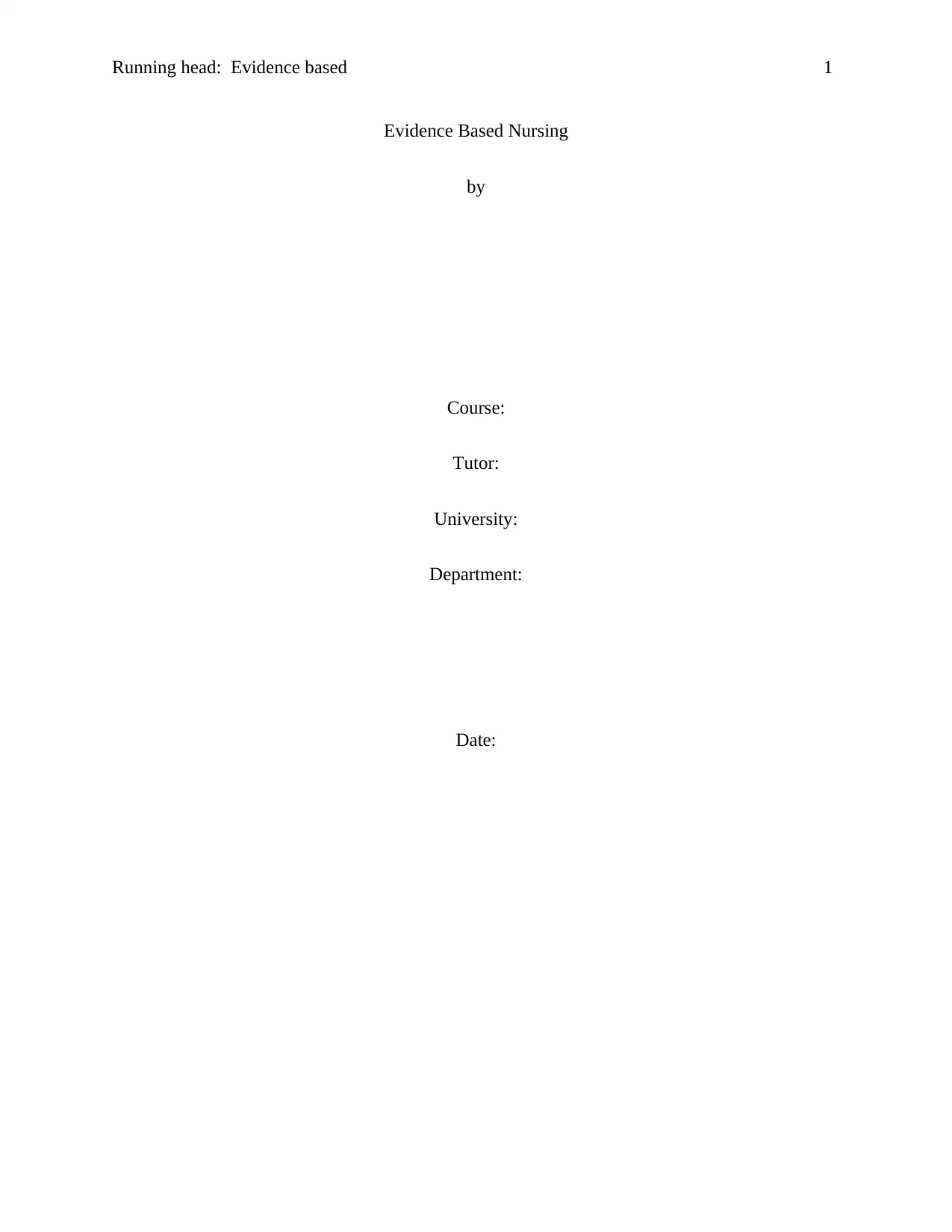
Running head: Evidence based 1
Evidence Based Nursing
by
Course:
Tutor:
University:
Department:
Date:
Evidence Based Nursing
by
Course:
Tutor:
University:
Department:
Date:
Secure Best Marks with AI Grader
Need help grading? Try our AI Grader for instant feedback on your assignments.
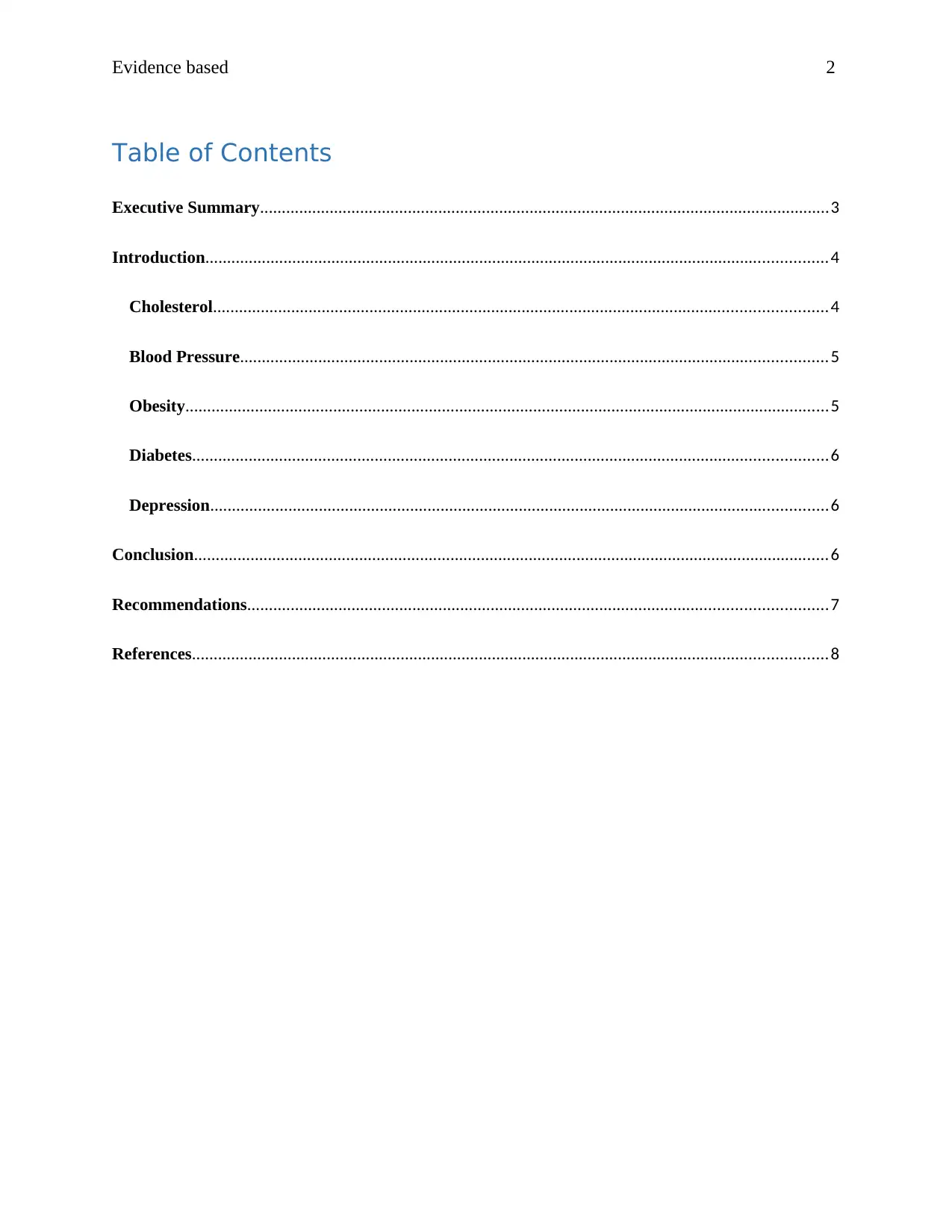
Evidence based 2
Table of Contents
Executive Summary...................................................................................................................................3
Introduction...............................................................................................................................................4
Cholesterol.............................................................................................................................................4
Blood Pressure.......................................................................................................................................5
Obesity....................................................................................................................................................5
Diabetes..................................................................................................................................................6
Depression..............................................................................................................................................6
Conclusion..................................................................................................................................................6
Recommendations.....................................................................................................................................7
References..................................................................................................................................................8
Table of Contents
Executive Summary...................................................................................................................................3
Introduction...............................................................................................................................................4
Cholesterol.............................................................................................................................................4
Blood Pressure.......................................................................................................................................5
Obesity....................................................................................................................................................5
Diabetes..................................................................................................................................................6
Depression..............................................................................................................................................6
Conclusion..................................................................................................................................................6
Recommendations.....................................................................................................................................7
References..................................................................................................................................................8

Evidence based 3
Executive Summary
Indigenous Australian peoples are the original residents of Australia and they comprise of
different Aboriginal communities with different local languages and cultures. The poor health of
the community has significantly been linked to health inequalities such as lack of access to
quality healthcare. As a result, the community has a greater burden of disease of 2.3 times more
than their counterparts. This essay will consider the most prevalent cardiovascular diseases
among the Indigenous community namely Cholesterol, Blood Pressure, Obesity, Diabetes and
depression. Emphasis is laid on the prevalence, causes and effects. Recommendations for
prevention of these diseases have been provided as well.
Executive Summary
Indigenous Australian peoples are the original residents of Australia and they comprise of
different Aboriginal communities with different local languages and cultures. The poor health of
the community has significantly been linked to health inequalities such as lack of access to
quality healthcare. As a result, the community has a greater burden of disease of 2.3 times more
than their counterparts. This essay will consider the most prevalent cardiovascular diseases
among the Indigenous community namely Cholesterol, Blood Pressure, Obesity, Diabetes and
depression. Emphasis is laid on the prevalence, causes and effects. Recommendations for
prevention of these diseases have been provided as well.
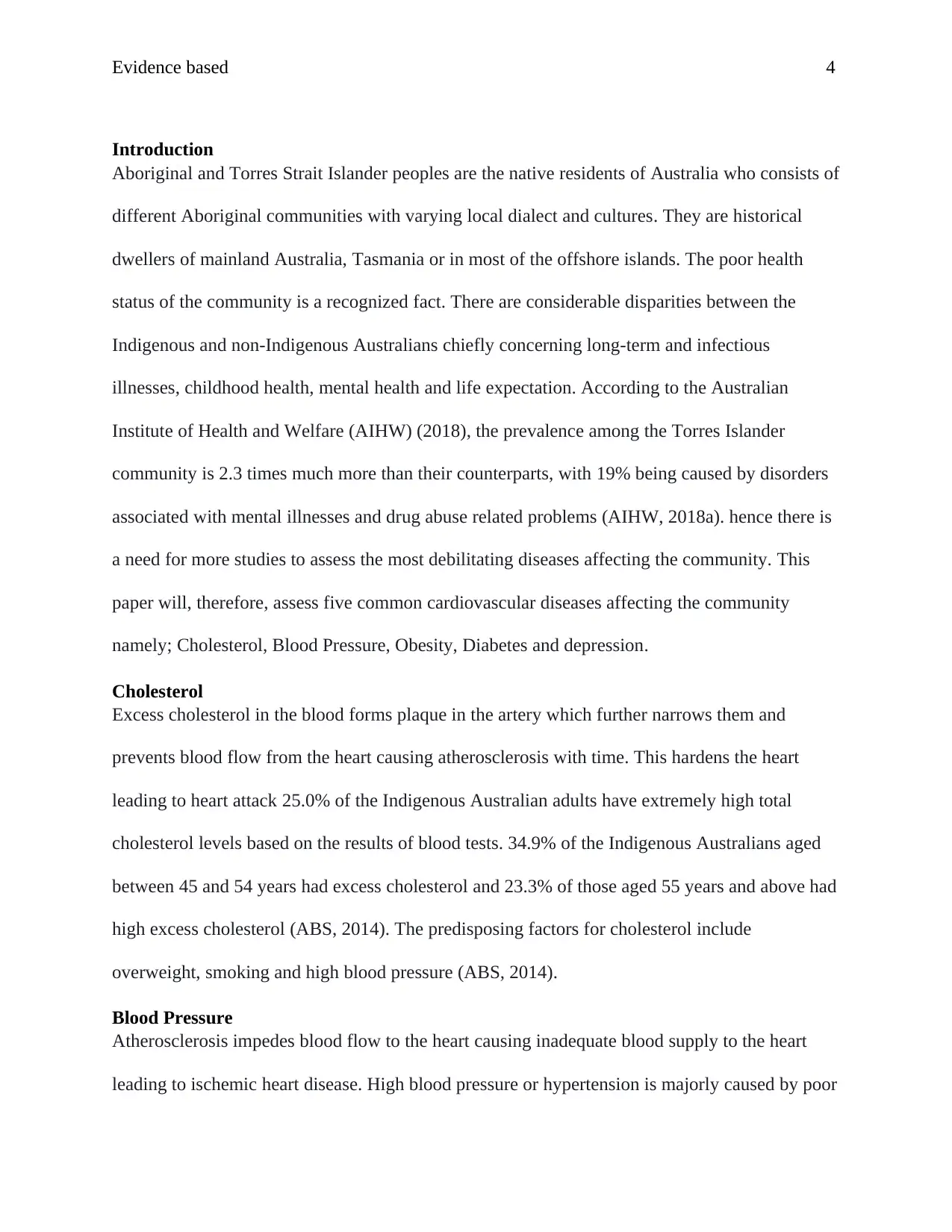
Evidence based 4
Introduction
Aboriginal and Torres Strait Islander peoples are the native residents of Australia who consists of
different Aboriginal communities with varying local dialect and cultures. They are historical
dwellers of mainland Australia, Tasmania or in most of the offshore islands. The poor health
status of the community is a recognized fact. There are considerable disparities between the
Indigenous and non-Indigenous Australians chiefly concerning long-term and infectious
illnesses, childhood health, mental health and life expectation. According to the Australian
Institute of Health and Welfare (AIHW) (2018), the prevalence among the Torres Islander
community is 2.3 times much more than their counterparts, with 19% being caused by disorders
associated with mental illnesses and drug abuse related problems (AIHW, 2018a). hence there is
a need for more studies to assess the most debilitating diseases affecting the community. This
paper will, therefore, assess five common cardiovascular diseases affecting the community
namely; Cholesterol, Blood Pressure, Obesity, Diabetes and depression.
Cholesterol
Excess cholesterol in the blood forms plaque in the artery which further narrows them and
prevents blood flow from the heart causing atherosclerosis with time. This hardens the heart
leading to heart attack 25.0% of the Indigenous Australian adults have extremely high total
cholesterol levels based on the results of blood tests. 34.9% of the Indigenous Australians aged
between 45 and 54 years had excess cholesterol and 23.3% of those aged 55 years and above had
high excess cholesterol (ABS, 2014). The predisposing factors for cholesterol include
overweight, smoking and high blood pressure (ABS, 2014).
Blood Pressure
Atherosclerosis impedes blood flow to the heart causing inadequate blood supply to the heart
leading to ischemic heart disease. High blood pressure or hypertension is majorly caused by poor
Introduction
Aboriginal and Torres Strait Islander peoples are the native residents of Australia who consists of
different Aboriginal communities with varying local dialect and cultures. They are historical
dwellers of mainland Australia, Tasmania or in most of the offshore islands. The poor health
status of the community is a recognized fact. There are considerable disparities between the
Indigenous and non-Indigenous Australians chiefly concerning long-term and infectious
illnesses, childhood health, mental health and life expectation. According to the Australian
Institute of Health and Welfare (AIHW) (2018), the prevalence among the Torres Islander
community is 2.3 times much more than their counterparts, with 19% being caused by disorders
associated with mental illnesses and drug abuse related problems (AIHW, 2018a). hence there is
a need for more studies to assess the most debilitating diseases affecting the community. This
paper will, therefore, assess five common cardiovascular diseases affecting the community
namely; Cholesterol, Blood Pressure, Obesity, Diabetes and depression.
Cholesterol
Excess cholesterol in the blood forms plaque in the artery which further narrows them and
prevents blood flow from the heart causing atherosclerosis with time. This hardens the heart
leading to heart attack 25.0% of the Indigenous Australian adults have extremely high total
cholesterol levels based on the results of blood tests. 34.9% of the Indigenous Australians aged
between 45 and 54 years had excess cholesterol and 23.3% of those aged 55 years and above had
high excess cholesterol (ABS, 2014). The predisposing factors for cholesterol include
overweight, smoking and high blood pressure (ABS, 2014).
Blood Pressure
Atherosclerosis impedes blood flow to the heart causing inadequate blood supply to the heart
leading to ischemic heart disease. High blood pressure or hypertension is majorly caused by poor
Secure Best Marks with AI Grader
Need help grading? Try our AI Grader for instant feedback on your assignments.
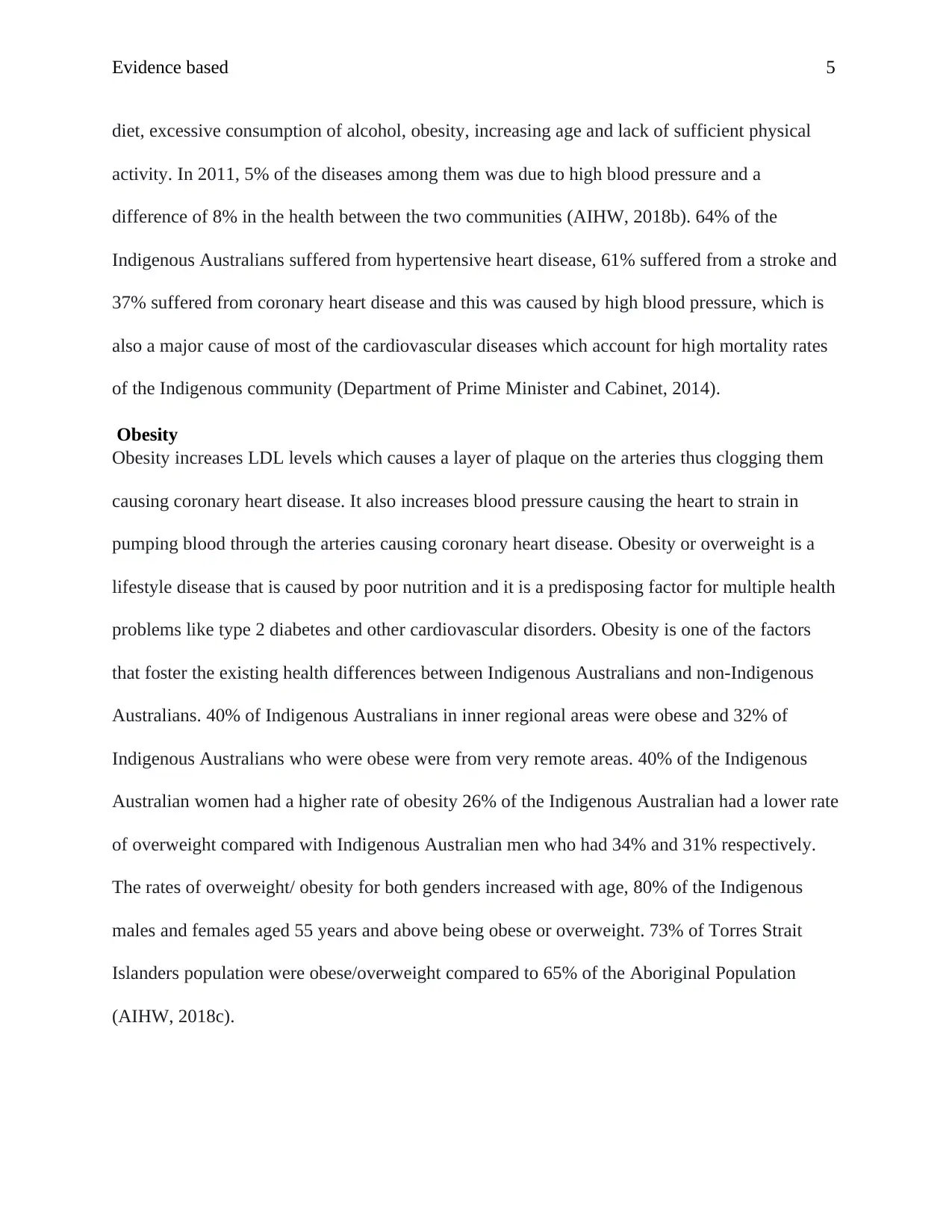
Evidence based 5
diet, excessive consumption of alcohol, obesity, increasing age and lack of sufficient physical
activity. In 2011, 5% of the diseases among them was due to high blood pressure and a
difference of 8% in the health between the two communities (AIHW, 2018b). 64% of the
Indigenous Australians suffered from hypertensive heart disease, 61% suffered from a stroke and
37% suffered from coronary heart disease and this was caused by high blood pressure, which is
also a major cause of most of the cardiovascular diseases which account for high mortality rates
of the Indigenous community (Department of Prime Minister and Cabinet, 2014).
Obesity
Obesity increases LDL levels which causes a layer of plaque on the arteries thus clogging them
causing coronary heart disease. It also increases blood pressure causing the heart to strain in
pumping blood through the arteries causing coronary heart disease. Obesity or overweight is a
lifestyle disease that is caused by poor nutrition and it is a predisposing factor for multiple health
problems like type 2 diabetes and other cardiovascular disorders. Obesity is one of the factors
that foster the existing health differences between Indigenous Australians and non-Indigenous
Australians. 40% of Indigenous Australians in inner regional areas were obese and 32% of
Indigenous Australians who were obese were from very remote areas. 40% of the Indigenous
Australian women had a higher rate of obesity 26% of the Indigenous Australian had a lower rate
of overweight compared with Indigenous Australian men who had 34% and 31% respectively.
The rates of overweight/ obesity for both genders increased with age, 80% of the Indigenous
males and females aged 55 years and above being obese or overweight. 73% of Torres Strait
Islanders population were obese/overweight compared to 65% of the Aboriginal Population
(AIHW, 2018c).
diet, excessive consumption of alcohol, obesity, increasing age and lack of sufficient physical
activity. In 2011, 5% of the diseases among them was due to high blood pressure and a
difference of 8% in the health between the two communities (AIHW, 2018b). 64% of the
Indigenous Australians suffered from hypertensive heart disease, 61% suffered from a stroke and
37% suffered from coronary heart disease and this was caused by high blood pressure, which is
also a major cause of most of the cardiovascular diseases which account for high mortality rates
of the Indigenous community (Department of Prime Minister and Cabinet, 2014).
Obesity
Obesity increases LDL levels which causes a layer of plaque on the arteries thus clogging them
causing coronary heart disease. It also increases blood pressure causing the heart to strain in
pumping blood through the arteries causing coronary heart disease. Obesity or overweight is a
lifestyle disease that is caused by poor nutrition and it is a predisposing factor for multiple health
problems like type 2 diabetes and other cardiovascular disorders. Obesity is one of the factors
that foster the existing health differences between Indigenous Australians and non-Indigenous
Australians. 40% of Indigenous Australians in inner regional areas were obese and 32% of
Indigenous Australians who were obese were from very remote areas. 40% of the Indigenous
Australian women had a higher rate of obesity 26% of the Indigenous Australian had a lower rate
of overweight compared with Indigenous Australian men who had 34% and 31% respectively.
The rates of overweight/ obesity for both genders increased with age, 80% of the Indigenous
males and females aged 55 years and above being obese or overweight. 73% of Torres Strait
Islanders population were obese/overweight compared to 65% of the Aboriginal Population
(AIHW, 2018c).

Evidence based 6
Diabetes
High blood glucose overtime damages blood vessels and nerves that regulate heart and blood
vessels causing stroke and heart attack. Diabetes is a chronic condition characteristic of
excessive blood sugar levels. Diabetes among Indigenous people is caused by dietary changes,
decreased rates of physical activity and high obesity cases. In 2012, type 2 diabetes was the most
common in Australia among the Indigenous Australian which accounted for 85% (AIHW, 2019).
11% of Indigenous Australians of ages 18 and over had diabetes in 2012-2013. 9.6% of the
Indigenous Australians aged 18 years and above knew they were diabetic and 1.5% of the
Indigenous Australian adults were newly diagnosed with diabetes. An estimated 14% of diabetes
incidences were initially diagnosed (AIHW, 2019).
Depression
Depression increases the risk of lifestyles linked to poor physical health such as drinking,
overeating, and smoking. These behaviors predispose one to cardiovascular disorders such as
high blood pressure, diabetes, and obesity which leads to ischemic heart disease, and coronary
heart disease respectively. Depression is a mental health condition marked by low mood, a
constant state of sorrow and disinterest in initial pleasures. Depression in the Aboriginal
community is caused by social isolation, poverty, and hopelessness. The survey by ABS (2014),
reported that one in three Indigenous had advanced depression and this was thrice higher than for
other Australians. Between 2001-2010 (ABS, 2014) 100 Indigenous Australians ended their lives
each year through suicide due to depression. 33% of Indigenous Australians who are early teens
were found to have developed marked depressive symptoms. This was twice the number
compared to other Australians.
Diabetes
High blood glucose overtime damages blood vessels and nerves that regulate heart and blood
vessels causing stroke and heart attack. Diabetes is a chronic condition characteristic of
excessive blood sugar levels. Diabetes among Indigenous people is caused by dietary changes,
decreased rates of physical activity and high obesity cases. In 2012, type 2 diabetes was the most
common in Australia among the Indigenous Australian which accounted for 85% (AIHW, 2019).
11% of Indigenous Australians of ages 18 and over had diabetes in 2012-2013. 9.6% of the
Indigenous Australians aged 18 years and above knew they were diabetic and 1.5% of the
Indigenous Australian adults were newly diagnosed with diabetes. An estimated 14% of diabetes
incidences were initially diagnosed (AIHW, 2019).
Depression
Depression increases the risk of lifestyles linked to poor physical health such as drinking,
overeating, and smoking. These behaviors predispose one to cardiovascular disorders such as
high blood pressure, diabetes, and obesity which leads to ischemic heart disease, and coronary
heart disease respectively. Depression is a mental health condition marked by low mood, a
constant state of sorrow and disinterest in initial pleasures. Depression in the Aboriginal
community is caused by social isolation, poverty, and hopelessness. The survey by ABS (2014),
reported that one in three Indigenous had advanced depression and this was thrice higher than for
other Australians. Between 2001-2010 (ABS, 2014) 100 Indigenous Australians ended their lives
each year through suicide due to depression. 33% of Indigenous Australians who are early teens
were found to have developed marked depressive symptoms. This was twice the number
compared to other Australians.

Evidence based 7
Conclusion
Aboriginal and Torres Strait Islander peoples have a greater burden of disease than the non-
indigenous peoples. Some of the chronic diseases include Cholesterol, Blood Pressure, Obesity,
Diabetes and depression. The high prevalence of the cardiovascular disease among the
Australian Indigenous is attributed to multiple disposing factors such as lack of access to healthy
foods, unhealthy nutrition habits among others. Each of these diseases has varying effects on the
quality of life and the predisposing factors in the community that increase their prevalence
among the non-indigenous community.
Recommendations
Poor nutrition is the major cause of the lifestyle diseases among Indigenous Australians.
Therefore, there is a need for nutrition education, proper dietary intake, and interventions to help
Indigenous Australians access healthy food, education on nutrition, financial management,
cooking programs and group-based lifestyle change programs. There is a need for programs to
increase food supply like focusing on food retail outlets, community food production by
Indigenous Australians (Leon, & Maddox, 2015). This will be a significant holistic method of
improving the health outcomes of the Indigenous Australians.
Conclusion
Aboriginal and Torres Strait Islander peoples have a greater burden of disease than the non-
indigenous peoples. Some of the chronic diseases include Cholesterol, Blood Pressure, Obesity,
Diabetes and depression. The high prevalence of the cardiovascular disease among the
Australian Indigenous is attributed to multiple disposing factors such as lack of access to healthy
foods, unhealthy nutrition habits among others. Each of these diseases has varying effects on the
quality of life and the predisposing factors in the community that increase their prevalence
among the non-indigenous community.
Recommendations
Poor nutrition is the major cause of the lifestyle diseases among Indigenous Australians.
Therefore, there is a need for nutrition education, proper dietary intake, and interventions to help
Indigenous Australians access healthy food, education on nutrition, financial management,
cooking programs and group-based lifestyle change programs. There is a need for programs to
increase food supply like focusing on food retail outlets, community food production by
Indigenous Australians (Leon, & Maddox, 2015). This will be a significant holistic method of
improving the health outcomes of the Indigenous Australians.
Paraphrase This Document
Need a fresh take? Get an instant paraphrase of this document with our AI Paraphraser
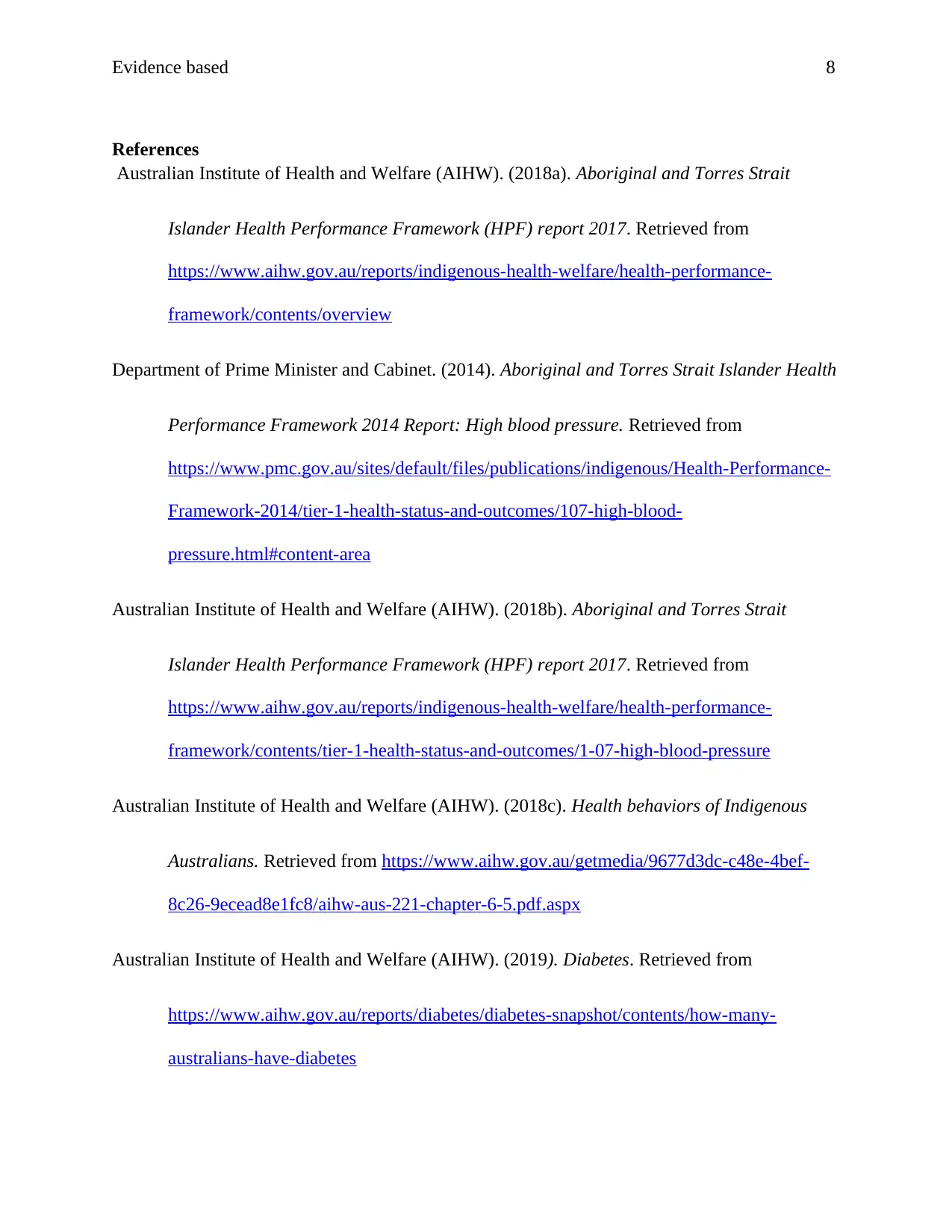
Evidence based 8
References
Australian Institute of Health and Welfare (AIHW). (2018a). Aboriginal and Torres Strait
Islander Health Performance Framework (HPF) report 2017. Retrieved from
https://www.aihw.gov.au/reports/indigenous-health-welfare/health-performance-
framework/contents/overview
Department of Prime Minister and Cabinet. (2014). Aboriginal and Torres Strait Islander Health
Performance Framework 2014 Report: High blood pressure. Retrieved from
https://www.pmc.gov.au/sites/default/files/publications/indigenous/Health-Performance-
Framework-2014/tier-1-health-status-and-outcomes/107-high-blood-
pressure.html#content-area
Australian Institute of Health and Welfare (AIHW). (2018b). Aboriginal and Torres Strait
Islander Health Performance Framework (HPF) report 2017. Retrieved from
https://www.aihw.gov.au/reports/indigenous-health-welfare/health-performance-
framework/contents/tier-1-health-status-and-outcomes/1-07-high-blood-pressure
Australian Institute of Health and Welfare (AIHW). (2018c). Health behaviors of Indigenous
Australians. Retrieved from https://www.aihw.gov.au/getmedia/9677d3dc-c48e-4bef-
8c26-9ecead8e1fc8/aihw-aus-221-chapter-6-5.pdf.aspx
Australian Institute of Health and Welfare (AIHW). (2019). Diabetes. Retrieved from
https://www.aihw.gov.au/reports/diabetes/diabetes-snapshot/contents/how-many-
australians-have-diabetes
References
Australian Institute of Health and Welfare (AIHW). (2018a). Aboriginal and Torres Strait
Islander Health Performance Framework (HPF) report 2017. Retrieved from
https://www.aihw.gov.au/reports/indigenous-health-welfare/health-performance-
framework/contents/overview
Department of Prime Minister and Cabinet. (2014). Aboriginal and Torres Strait Islander Health
Performance Framework 2014 Report: High blood pressure. Retrieved from
https://www.pmc.gov.au/sites/default/files/publications/indigenous/Health-Performance-
Framework-2014/tier-1-health-status-and-outcomes/107-high-blood-
pressure.html#content-area
Australian Institute of Health and Welfare (AIHW). (2018b). Aboriginal and Torres Strait
Islander Health Performance Framework (HPF) report 2017. Retrieved from
https://www.aihw.gov.au/reports/indigenous-health-welfare/health-performance-
framework/contents/tier-1-health-status-and-outcomes/1-07-high-blood-pressure
Australian Institute of Health and Welfare (AIHW). (2018c). Health behaviors of Indigenous
Australians. Retrieved from https://www.aihw.gov.au/getmedia/9677d3dc-c48e-4bef-
8c26-9ecead8e1fc8/aihw-aus-221-chapter-6-5.pdf.aspx
Australian Institute of Health and Welfare (AIHW). (2019). Diabetes. Retrieved from
https://www.aihw.gov.au/reports/diabetes/diabetes-snapshot/contents/how-many-
australians-have-diabetes
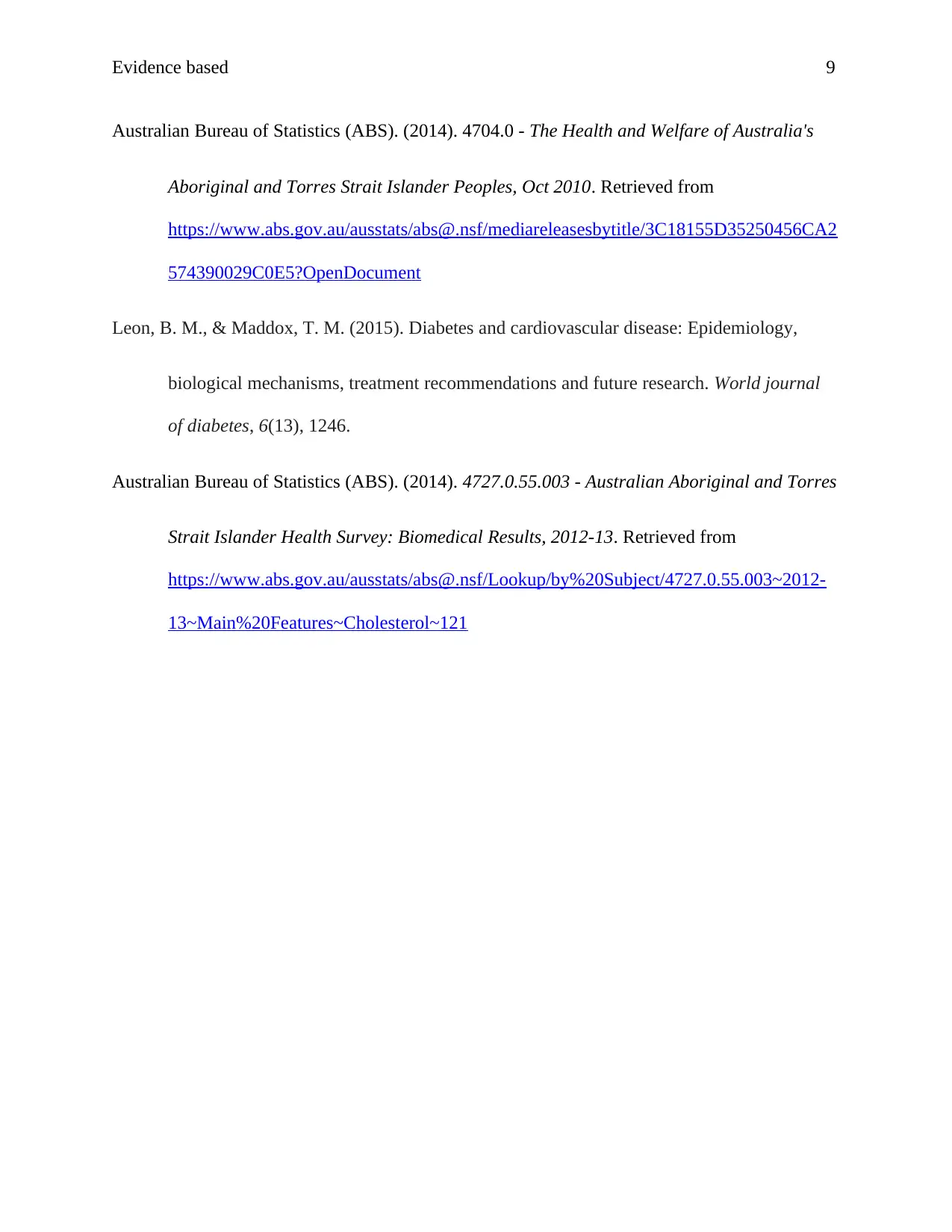
Evidence based 9
Australian Bureau of Statistics (ABS). (2014). 4704.0 - The Health and Welfare of Australia's
Aboriginal and Torres Strait Islander Peoples, Oct 2010. Retrieved from
https://www.abs.gov.au/ausstats/abs@.nsf/mediareleasesbytitle/3C18155D35250456CA2
574390029C0E5?OpenDocument
Leon, B. M., & Maddox, T. M. (2015). Diabetes and cardiovascular disease: Epidemiology,
biological mechanisms, treatment recommendations and future research. World journal
of diabetes, 6(13), 1246.
Australian Bureau of Statistics (ABS). (2014). 4727.0.55.003 - Australian Aboriginal and Torres
Strait Islander Health Survey: Biomedical Results, 2012-13. Retrieved from
https://www.abs.gov.au/ausstats/abs@.nsf/Lookup/by%20Subject/4727.0.55.003~2012-
13~Main%20Features~Cholesterol~121
Australian Bureau of Statistics (ABS). (2014). 4704.0 - The Health and Welfare of Australia's
Aboriginal and Torres Strait Islander Peoples, Oct 2010. Retrieved from
https://www.abs.gov.au/ausstats/abs@.nsf/mediareleasesbytitle/3C18155D35250456CA2
574390029C0E5?OpenDocument
Leon, B. M., & Maddox, T. M. (2015). Diabetes and cardiovascular disease: Epidemiology,
biological mechanisms, treatment recommendations and future research. World journal
of diabetes, 6(13), 1246.
Australian Bureau of Statistics (ABS). (2014). 4727.0.55.003 - Australian Aboriginal and Torres
Strait Islander Health Survey: Biomedical Results, 2012-13. Retrieved from
https://www.abs.gov.au/ausstats/abs@.nsf/Lookup/by%20Subject/4727.0.55.003~2012-
13~Main%20Features~Cholesterol~121
1 out of 9
Related Documents
Your All-in-One AI-Powered Toolkit for Academic Success.
+13062052269
info@desklib.com
Available 24*7 on WhatsApp / Email
![[object Object]](/_next/static/media/star-bottom.7253800d.svg)
Unlock your academic potential
© 2024 | Zucol Services PVT LTD | All rights reserved.





